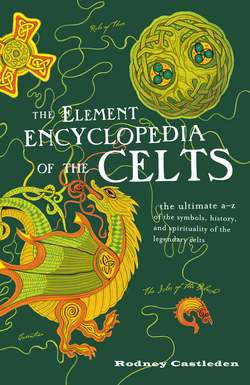Читать книгу The Element Encyclopedia of the Celts - Rodney Castleden - Страница 13
THE ATLANTIC CELTS
ОглавлениеWe have to set aside the long-held assumption that the Celts were a pan-European Iron Age race. This means rethinking European prehistory. Modern archeological and anthropological evidence is pointing toward a reality that is far more exciting.
Instead of the Celts of the west being relative newcomers, arriving in the Atlantic coastlands between 2,000 and 3,000 years ago, they are emerging as an indigenous people with a very ancient ancestry indeed. Ten thousand years ago, the last cold stage of the Ice Age was ending and the ice that had covered much of Britain and Ireland was melting back. After the long glacial episode, the islands were becoming habitable again. What happened then was that people living in refuges in northern Spain began to migrate northward, bay-hopping along the coast, to colonize the lands that were thawing out. These early migrants spread through exactly the areas that we now think of as Celtic—Galicia, Brittany, Cornwall, Wales, and Scotland—plus a margin along their eastern edges—northern Spain, the Bay of Biscay coast of France, Normandy, and the whole of England. This is where the Celtic ancestry of Britain (England included) came from—this ancient migration from the south.
The people we call Celts were the descendants of these Middle Stone Age hunters, gatherers, and fishermen, and of the New Stone Age farmers, pastoralists, and stone circle builders who succeeded them.
One of the stone circles, Stonehenge, has become an emblem of Celtic Britain. Modern Druids have claimed it as theirs, and we could question this entitlement, but this process of claiming and adopting has probably been repeated over and over again through time. Stonehenge was once thought to be the work of a Mycenaean architect, partly because of the similarity between the stone trilithons and the architecture of the great Lion Gate at Mycenae, built in 1250 BC, and there are carvings on the stones that seem to show a Mycenaean dagger. But now radiocarbon dates show that they were raised long before that, in 2500 BC. The earth circle round them dates from 3100 BC, and the totem poles that stood close by were raised in 8000–7000 BC. Stonehenge turns out to be a monument that was modified and developed repeatedly, by indigenous people, during the course of the long evolution of the Atlantic Celtic culture. The site witnessed and expressed the whole span of the Atlantic Celts’ prehistory.
Most of the big standing stones in the lands of the Atlantic Celts were raised in the Neolithic (3000– 2000 BC), some in the Bronze Age (2000–600 BC), and a small number in the Iron Age. They clearly speak of the bond the Atlantic Celts had developed with standing stones.
The megaliths that are known to belong to the Iron Age tend to be relatively small—man-height—and single monoliths only. Some are simple, tapering, and rounded pillars, others are fluted like Doric columns. Another group is low and rounded, almost cushion-shaped, like the Turoe Stone in County Galway.
The Christian Celts of later centuries remained interested in the earlier megaliths. They Christianized some of the old pagan stones, converting them by carving their tops into crude crosses. They even raised a brand-new family of megaliths: magnificently carved massive Celtic crosses such as Muireadach’s Cross at Monasterboice in Ireland.
Big standing stones were a part of the Atlantic Celtic consciousness all the way through.
Another link across this long span of time was made in 1996, when the remains of Cheddar Man were subjected to DNA analysis. Cheddar Man is the complete skeleton of a man who lived in Somerset in 7150 BC and when he died was buried in Gough’s Cave at Cheddar. It was found that this Stone Age man’s DNA was a close match with that of a local teacher, Adrian Targett. So, a man living and working at the Community School in Cheddar in the late twentieth century turned out to be a direct descendant of someone living in the same place more than 9,000 years before.
